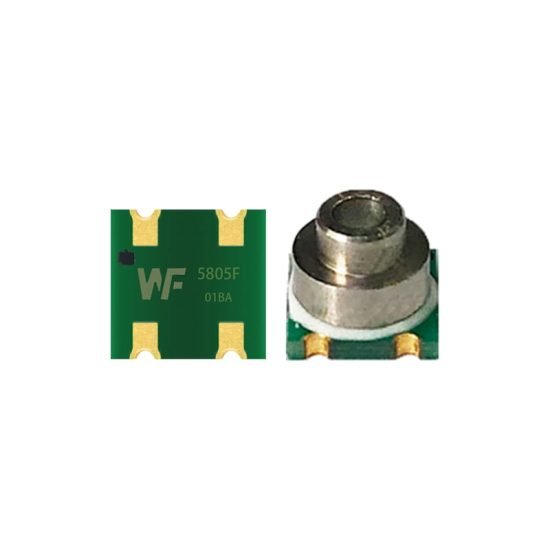カタログ
Depth detection sensors work on the basis of hydrostatic pressure. With compact MEMS devices like the WF5805-05BA, plus sealing and signal electronics, pressure is quickly converted into reliable depth readings. For underwater robots, diving systems and control platforms, these sensors are critical to achieving precise positioning and stable control.
1. Sensor and hardware traits
WF5805-05BAおよび同様のMEMSセンサー
The WF5805-05BA is part of a family of high-precision MEMS absolute/relative pressure sensors, usually in small SMD packages with a metal port on top. The silicon element inside is micro-machined for high sensitivity and low temperature drift, while the pins and sealing materials make it reliable in long-term use. These features suit ROVs, AUVs and diving gear where repeatability and linearity are vital.

2. Operating principle and depth conversion
水圧から深さまで
What the sensor measures is static water pressure. The physics is simple: pressure rises with depth, ΔP = ρ·g·Δh. The sensor’s voltage or digital signal is corrected using calibration factors, local density and gravity, then converted into depth. For accuracy, systems also allow for temperature and salinity changes that affect water density, adding those as compensation terms.
3. Packaging, sealing and interface design
フィールドでの展開用パッケージ
A depth sensor for underwater work has to balance pressure tolerance, corrosion resistance and electrical isolation. WF5805-05BA types often use a metal port or isolation diaphragm, sealed with epoxy, in a solder-mount package. Design considerations include avoiding blockage, preventing electrochemical corrosion, and controlling drift over long immersion periods.
4. Data handling, sampling and accuracy assurance
生センサーの出力から使用可能な深さまで
Accurate depth control depends on sampling stability, clean signal amplification and precise ADC conversion. Key points are choosing a sampling rate that balances bandwidth with filter delay, adding compensation for temperature and salinity, and building error budgets and drift monitoring into firmware. Calibration of zero, span and curve makes sure depth readings stay within engineering tolerance.
5. Precision control in underwater engineering
センサーが制御と実行を改善する方法
Integrating accurate depth feedback into a control loop boosts the fine-tuning of thrusters and rudders, cutting overshoot and oscillation. For operations like pipeline laying, survey marker positioning or close-to-seabed work, stable sensor readings reduce convergence time and steady-state error. In short, better sensor stability allows tighter gain settings and more robust fault tolerance in controllers.
結論
Depth detection sensors built on MEMS pressure elements, combined with robust packaging and solid data handling, turn water pressure into reliable depth data. For underwater projects, selecting the right device (such as the WF5805-05BA), optimising sealing and interfaces, and enforcing calibration are the foundation of accurate and stable control.
上記の紹介は、圧力センサー技術のアプリケーションの表面をなぞっただけです。私たちは、さまざまな製品で使用されているさまざまなタイプのセンサー素子、それらがどのように機能するか、そしてそれらの長所と短所を引き続き調査していきます。ここで説明する内容についてさらに詳しく知りたい場合は、このガイドの後半にある関連コンテンツをご覧ください。時間がない場合は、ここをクリックしてこのガイドの詳細をダウンロードすることもできます。 空気圧センサー製品PDFデータ。
他のセンサー技術の詳細については、こちらをご覧ください。 センサーページにアクセスしてください。
